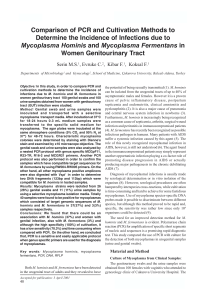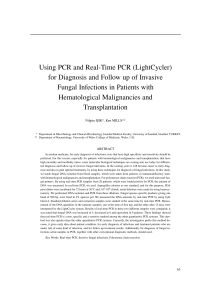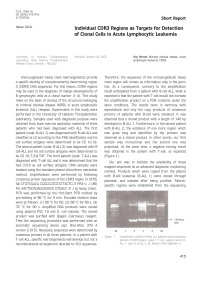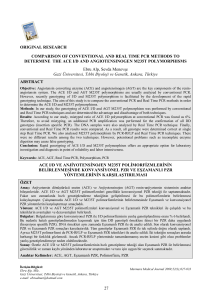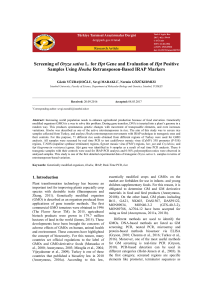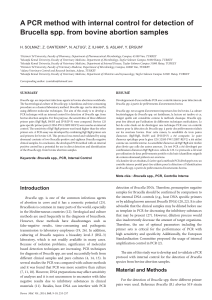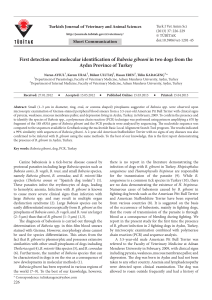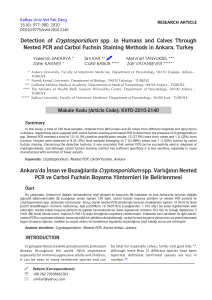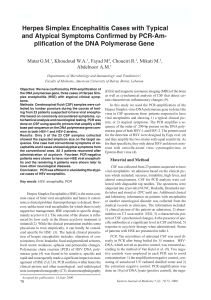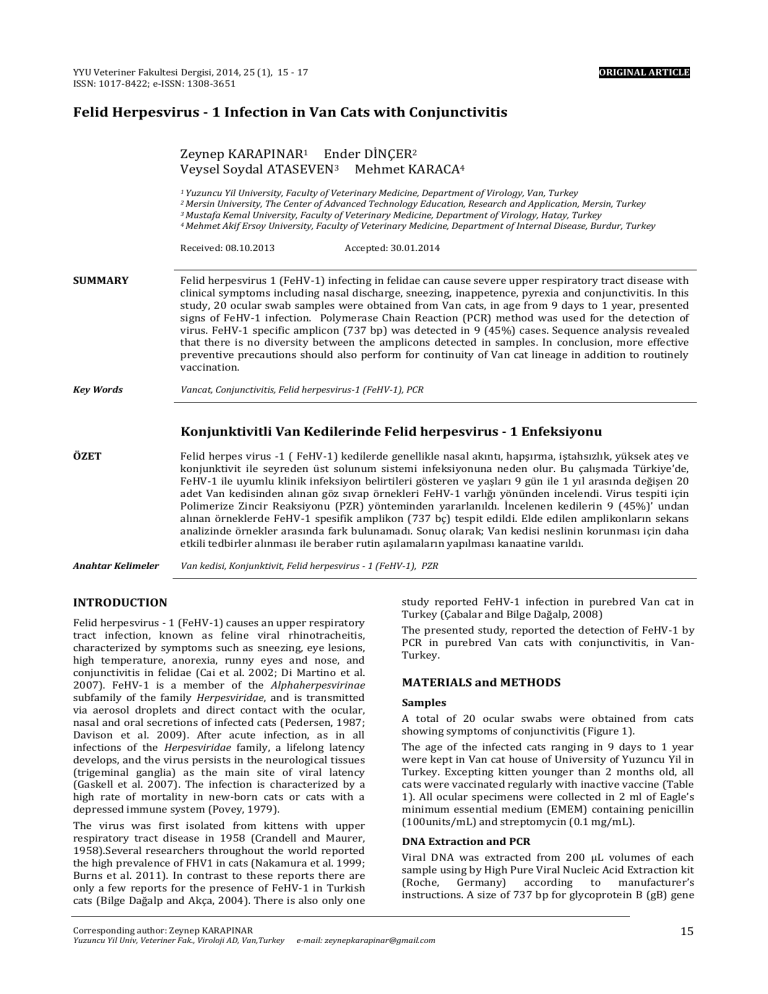
YYU Veteriner Fakultesi Dergisi, 2014, 25 (1), 15 - 17
ISSN: 1017-8422; e-ISSN: 1308-3651
ORIGINAL ARTICLE
Felid Herpesvirus - 1 Infection in Van Cats with Conjunctivitis
Zeynep KARAPINAR1 Ender DİNÇER2
Veysel Soydal ATASEVEN3 Mehmet KARACA4
1 Yuzuncu
Yil University, Faculty of Veterinary Medicine, Department of Virology, Van, Turkey
University, The Center of Advanced Technology Education, Research and Application, Mersin, Turkey
3 Mustafa Kemal University, Faculty of Veterinary Medicine, Department of Virology, Hatay, Turkey
4 Mehmet Akif Ersoy University, Faculty of Veterinary Medicine, Department of Internal Disease, Burdur, Turkey
2 Mersin
Received: 08.10.2013
Accepted: 30.01.2014
SUMMARY
Felid herpesvirus 1 (FeHV-1) infecting in felidae can cause severe upper respiratory tract disease with
clinical symptoms including nasal discharge, sneezing, inappetence, pyrexia and conjunctivitis. In this
study, 20 ocular swab samples were obtained from Van cats, in age from 9 days to 1 year, presented
signs of FeHV-1 infection. Polymerase Chain Reaction (PCR) method was used for the detection of
virus. FeHV-1 specific amplicon (737 bp) was detected in 9 (45%) cases. Sequence analysis revealed
that there is no diversity between the amplicons detected in samples. In conclusion, more effective
preventive precautions should also perform for continuity of Van cat lineage in addition to routinely
vaccination.
Key Words
Vancat, Conjunctivitis, Felid herpesvirus-1 (FeHV-1), PCR
Konjunktivitli Van Kedilerinde Felid herpesvirus - 1 Enfeksiyonu
ÖZET
Felid herpes virus -1 ( FeHV-1) kedilerde genellikle nasal akıntı, hapşırma, iştahsızlık, yüksek ateş ve
konjunktivit ile seyreden üst solunum sistemi infeksiyonuna neden olur. Bu çalışmada Türkiye’de,
FeHV-1 ile uyumlu klinik infeksiyon belirtileri gösteren ve yaşları 9 gün ile 1 yıl arasında değişen 20
adet Van kedisinden alınan göz sıvap örnekleri FeHV-1 varlığı yönünden incelendi. Virus tespiti için
Polimerize Zincir Reaksiyonu (PZR) yönteminden yararlanıldı. İncelenen kedilerin 9 (45%)’ undan
alınan örneklerde FeHV-1 spesifik amplikon (737 bç) tespit edildi. Elde edilen amplikonların sekans
analizinde örnekler arasında fark bulunamadı. Sonuç olarak; Van kedisi neslinin korunması için daha
etkili tedbirler alınması ile beraber rutin aşılamaların yapılması kanaatine varıldı.
Anahtar Kelimeler
Van kedisi, Konjunktivit, Felid herpesvirus - 1 (FeHV-1), PZR
INTRODUCTION
Felid herpesvirus - 1 (FeHV-1) causes an upper respiratory
tract infection, known as feline viral rhinotracheitis,
characterized by symptoms such as sneezing, eye lesions,
high temperature, anorexia, runny eyes and nose, and
conjunctivitis in felidae (Cai et al. 2002; Di Martino et al.
2007). FeHV-1 is a member of the Alphaherpesvirinae
subfamily of the family Herpesviridae, and is transmitted
via aerosol droplets and direct contact with the ocular,
nasal and oral secretions of infected cats (Pedersen, 1987;
Davison et al. 2009). After acute infection, as in all
infections of the Herpesviridae family, a lifelong latency
develops, and the virus persists in the neurological tissues
(trigeminal ganglia) as the main site of viral latency
(Gaskell et al. 2007). The infection is characterized by a
high rate of mortality in new-born cats or cats with a
depressed immune system (Povey, 1979).
The virus was first isolated from kittens with upper
respiratory tract disease in 1958 (Crandell and Maurer,
1958).Several researchers throughout the world reported
the high prevalence of FHV1 in cats (Nakamura et al. 1999;
Burns et al. 2011). In contrast to these reports there are
only a few reports for the presence of FeHV-1 in Turkish
cats (Bilge Dağalp and Akça, 2004). There is also only one
Corresponding author: Zeynep KARAPINAR
Yuzuncu Yil Univ, Veteriner Fak., Viroloji AD, Van,Turkey
study reported FeHV-1 infection in purebred Van cat in
Turkey (Çabalar and Bilge Dağalp, 2008)
The presented study, reported the detection of FeHV-1 by
PCR in purebred Van cats with conjunctivitis, in VanTurkey.
MATERIALS and METHODS
Samples
A total of 20 ocular swabs were obtained from cats
showing symptoms of conjunctivitis (Figure 1).
The age of the infected cats ranging in 9 days to 1 year
were kept in Van cat house of University of Yuzuncu Yil in
Turkey. Excepting kitten younger than 2 months old, all
cats were vaccinated regularly with inactive vaccine (Table
1). All ocular specimens were collected in 2 ml of Eagle’s
minimum essential medium (EMEM) containing penicillin
(100units/mL) and streptomycin (0.1 mg/mL).
DNA Extraction and PCR
Viral DNA was extracted from 200 µL volumes of each
sample using by High Pure Viral Nucleic Acid Extraction kit
(Roche,
Germany)
according
to
manufacturer’s
instructions. A size of 737 bp for glycoprotein B (gB) gene
e-mail: [email protected]
15
[Zeynep KARAPINAR et al.]
of FeHV-1 was amplified by PCR, using primer set as
described by Vögtlin et al. (2002). The PCR mix, with a
total volume of 30µL, contained 3µL of extracted DNA, 3µL
of Taq buffer (10×,750 mM Tris-HCl, 200 mM (NH4)2SO4,
0.1% (v/v) Tween 20), 2µL of the MgCl2 (25mM), 1µL of
each primer (10mM), 1µL of the four deoxynucleoside
triphosphates (10 mM) solution, 0,25 µL of Taq DNA
polymerase (5U/µL), and 18,75µL of molecular biology
grade water (Thermoscientific, USA). Sterile molecular
biology grade water was also used as a negative control.
The PCR reactions were performed using a thermalcycler
(Techne 3000G, BibbyScientific Ltd., UK) and using an
initial denaturation at 95°C for 4 min followed by 27 cycles
consisting of denaturation (95°C for 45 min), annealing
(55°C for 1 min) and elongation (72°C for 1 min) as there
action conditions. The PCR products were visualized using
by a transilluminator after separation on a 2% agarose gel
(Figure 2).
YYU Vet Fak Derg
with clinical symptoms such as upper respiratory disease
and conjunctivitis (Harbour et al. 1991; Stiles et al. 1997;
Bilge Dağalp and Akça 2004; Burns et al. 2011). However,
FeHV-1 could also be detected in the healthy cats as high
as in 63% (Harbour et al. 1991; Kang and Park, 2008).
Furthermore, previous studies reported also a high
seropositivity (58.3%) in Van cats with upper respiratory
tract disease and conjunctivitis from the same Van cat
house in Turkey, where the present study is performed
(Çabalar and Bilge Dağalp 2008).
In the presented study, ocular samples from 20 cats with
conjunctivitis were examined for FeHV-1 by PCR. FeHV-1
was detected in 9 (45%) cats with conjunctivitis. In the
cathouse, new-born cats were kept in separate room
together with their mothers for one month and then were
moved to the common area. Two mother cats and their
kittens marked with 1 and 4 were positive for FHV1. But
another mother cat marked with 2 was found to be
negative for FeHV-1, however two of her three kittens
were positive for FeHV-1. Both mother cat and her kitten
marked with 3 were negative for FeHV-1 (Table 1).
Table 1. Distribution of cats with conjunctivitis to their
ages and to PCR results
Figure 1. The ocular sign in a Van cat with conjunctivitis
Figure 2. PCR amplification products using FeHV-1
primers. Lane M: 100-bp DNA ladder marker
(Thermoscientific); lane 1, 2and 3: positive amplification
PCR products; lane 4: negative control (distilled water)
DNA Sequencing
FeHV-1 specific DNA in these samples was confirmed by
sequence analysis (Beckman Coulter CEQ 8000, USA).
Positive amplicons were sequenced commercially. The
accession numbers of gB gene sequences of Turkish FeHV1 strains in the GenBank were recorded as KC529346,
KC529347 and KC529348 respectively.
RESULTS and DISCUSSION
Recent studies indicated that FeHV-1 was detected in
higher portion in cats, especially in shelter cats (BilgeDağalp and Akça 2004, Burns et al. 2011). Prevalence of
FeHV-1 varied from 4.2% to 90.1% was reported in cats
16
No of cats
Age of cats
FeHV-1 DNA
1
1 year 1,a
+
2
9 days
1,b
+
3
9 days 1,b
+
4
1 year
-
2,a
5
15 days 2,b
+
6
15 days 2,b
-
7
15 days 2,b
+
8
1 year 3,a
-
9
10 days 3,b
-
10
1 year 4,a
+
11
10 days
4,b
+
12
2 months b
+
13
2 months
b
+
14
2 months b
-
15
2 months
b
-
16
3 months a
-
17
10 months
a
-
18
10 months a
-
19
10 months
-
20
1 year a
1, 2, 3, 4Mother
a
-
cats and their kittens; a vaccinated; b unvaccinated
It is likely that the source of infection is originated from
their mothers which would be latently infected with FeHV1. Latently infected cats may also be an important health
risks for cat population in shelter as described elsewhere
(Gaskell and Povey, 1982; Weigler et al. 1997; Bilge Dağalp
and Akça 2004).
On the other hand, out of the 9 cats aged over 2 mounts
without kittens, only two cats were found positive for
FeHV-1, which may also be source of FeHV-1 infection for
kittens or their mothers examined in this study (Table 1).
Other studies suggested also that vaccination cannot
protect cats from infection, but it may reduce the term and
amount of virus shedding (Gaskell and Willoughby, 1999).
[FeHV-1 infection in Van cats]
In conclusion, this result indicates that FeHV-1 infection
has still been circulating in Van cat house in Turkey.
Future studies should be performed to identify the
presence of other viral and bacterial pathogens such as
feline calicivirus and Chlamydophila felis in shelters
because some of clinically diseased cats were determined
not be positive for FeHV-1. More effective preventive
precaution in addition to routine vaccination should be
performed to ensure the continuity of Van cat lineage.
ACKNOWLEDGEMENTS
We wish to thank Prof. Dr. Hasan Altan AKKAN from
Department of Internal Diseases, Faculty of Veterinary
Medicine, University of Yuzuncu Yil for his support and
help to this study.
REFERENCES
Bilge Dağalp S, Akça Y (2004). Detection of feline herpesvirus-1 from
domestic cats with or without respiratory symptoms. Indian Vet J, 81,
11-15.
Çabalar M, Bilge Dağalp S (2008). Feline herpesvirus-1 infection in
Turkish Van cats with conjunctivitis and upper respiratory tract
disease. In: XIV. International Congress of Virology, Istanbul, Turkey;
pp. 288.
Burns RE, Wagner DC, Leutenegger CM, Pesavento PA (2011).
Histologic and molecular correlation in shelter cats with acute upper
respiratory infection. J Clin Microbiol, 49, 2454-2460.
Cai Y, Fukushi H, Koyasu S, Kuroda E, Yamaguchi T, Hirai K (2002). An
etiological investigation of domestic cats with conjunctivitis and upper
respiratory tract disease in Japan. J Vet Med Sci, 64, 215-219.
Crandell RA, Maurer FD (1958). Isolation of a feline virus associated with
intranuclear inclusion bodies. Proc Soc Exp Biol Med, 97, 487–490.
Davison AJ, Eberle R, Ehlers B, Hayward GS, McGeoch DJ, Minson AC,
Pellett PE, Roizman B, Studdert MJ, Thiry E (2009). The order
Herpesvirales. Arch Virol, 154, 171-177.
YYU Vet Fak Derg
Di Martino B, Di Francesco CE, Meridiani I, Marsilio F (2007).
Etiological investigation of multiple respiratory infections in cats. New
Microbiol, 30, 455-461.
Gaskell RM, Povey RC (1982). Transmission of feline viral rhinotracheitis.
Vet Rec, 111, 359-362.
Gaskell RM, Willoughby K (1999). Herpesviruses of carnivores. Vet
Microbiol, 69, 73-88.
Gaskell R, Dawson S, Radford A, Thiry E (2007). Feline herpesvirus.Vet
Res, 38, 337-354.
Harbour DA, Howard PE, Gaskell RM (1991). Isolation of feline
calicivirus and feline herpesvirus from domestic cats 1980 to 1989.
VetRec,128,77- 80.
Kang BT, Park HM (2008). Prevalence of feline herpesvirus 1, feline
calicivirus and Chlamydophila felis in clinically normal cats at a Korean
animal shelter. J Vet Sci, 9, 207-209.
Nakamura K, Ikeda Y, Miyazawa T, Nguyen NTP, Duong DD, Le KH, Vo
SD, Phan LV, Mikami T, Takahashi E (1999). Comparison of
prevalence of feline herpesvirus type 1, calicivirus and parvovirus
infections in domestic and leopard cats in Vietnam. J Vet Med Sci, 61,
1313-1315.
Pedersen NC (1987). Feline herpesvirus type 1 (feline rhinotracheitis
virus). In: Appel MJ, editor.Virus infections of carnivores. Amsterdam:
Elsevier Science Publishers, pp. 227–237.
Povey RC (1979). A review of feline viral rhinotracheitis (feline
herpesvirus 1 infection). Comp Immunol Microbiol Infect Dis, 2, 373–
387.
Stiles J, McDermott M, Bigsby D, Willis M, Martin C, Roberts W, Greene
C (1997). Use of nested polymerase chain reaction to identify feline
herpesvirus in ocular tissue from clinically normal cats and cats with
corneal sequestra or conjunctivitis. Am J Vet Res, 58, 338–342.
Vögtlin A, Fraefel C, Albini S, Leutenegger CM, Schraner E, Spiess B,
Lutz H, Ackermann M (2002). Quantification of feline herpesvirus 1
DNA in ocular fluid samples of clinically diseased cats by real-time
TaqMan PCR. J Clin Microbil, 40, 519–523.
Weigler BJ, Guy JS, Nasisse MP, Hancock SI, Sherry B (1997). Effect of a
live attenuated intranasal vaccine on latency and shedding of feline
herpesvirus 1 in domestic cats. Arch Virol,142, 2389-400.
17



